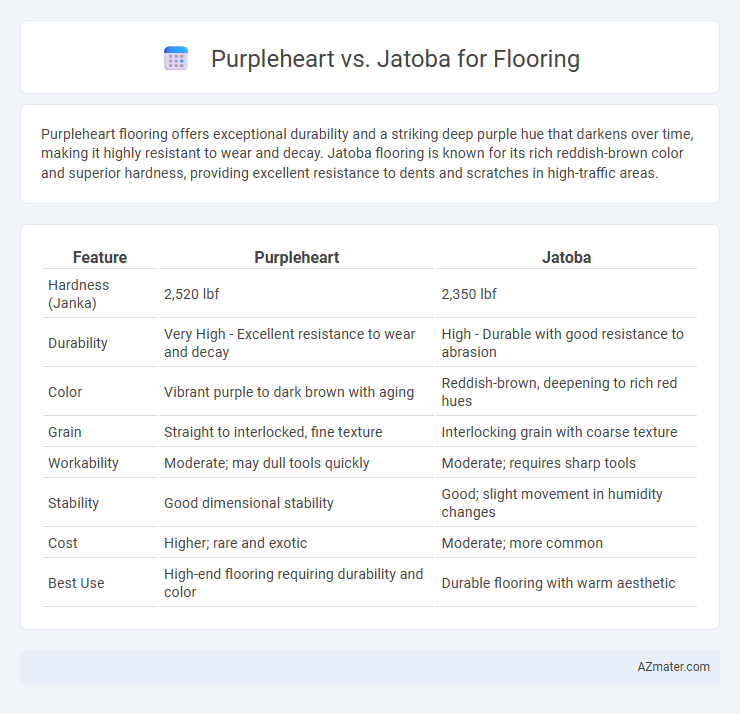Purpleheart flooring offers exceptional durability and a striking deep purple hue that darkens over time, making it highly resistant to wear and decay. Jatoba flooring is known for its rich reddish-brown color and superior hardness, providing excellent resistance to dents and scratches in high-traffic areas.
Table of Comparison
| Feature | Purpleheart | Jatoba |
|---|---|---|
| Hardness (Janka) | 2,520 lbf | 2,350 lbf |
| Durability | Very High - Excellent resistance to wear and decay | High - Durable with good resistance to abrasion |
| Color | Vibrant purple to dark brown with aging | Reddish-brown, deepening to rich red hues |
| Grain | Straight to interlocked, fine texture | Interlocking grain with coarse texture |
| Workability | Moderate; may dull tools quickly | Moderate; requires sharp tools |
| Stability | Good dimensional stability | Good; slight movement in humidity changes |
| Cost | Higher; rare and exotic | Moderate; more common |
| Best Use | High-end flooring requiring durability and color | Durable flooring with warm aesthetic |
Introduction to Purpleheart and Jatoba Flooring
Purpleheart flooring is prized for its striking natural purple hues and exceptional durability, making it a standout choice for high-traffic areas. Jatoba flooring, also known as Brazilian Cherry, offers a rich reddish-brown color with excellent hardness and resistance to wear, ideal for both residential and commercial spaces. Both hardwoods provide unique aesthetic appeal and robust performance, with Purpleheart delivering vibrant color and Jatoba renowned for its deep warmth and stability.
Origin and Botanical Background
Purpleheart flooring comes from the Peltogyne genus, native to Central and South American rainforests, known for its rich purple hue and durability. Jatoba, derived from the Hymenaea courbaril species, predominantly grows in the tropical forests of Central and South America and is prized for its deep reddish-brown color and hardness. Both woods belong to the Fabaceae family, offering distinctive botanical traits that contribute to their popularity in resilient, high-quality flooring solutions.
Appearance: Color, Grain, and Texture
Purpleheart flooring exhibits a rich, vibrant purple hue that deepens over time, contrasting with Jatoba's warm reddish-brown tones that range from orange to deep red. The grain of Purpleheart is generally straight to interlocked with a smooth, fine texture, while Jatoba displays a distinctive interlocking grain pattern with a coarse, uneven texture. Both woods offer unique visual appeal, but Purpleheart is favored for its striking, uncommon coloration, whereas Jatoba provides a classic, elegant look with greater color variation.
Hardness and Durability Comparison
Purpleheart flooring boasts a Janka hardness rating of approximately 2,520 lbs, making it highly resistant to wear and dents. Jatoba, with a higher Janka hardness of about 2,690 lbs, offers superior durability against daily impact and heavy foot traffic. Both woods provide excellent longevity, but Jatoba's slightly greater hardness makes it more suitable for areas with intense use and heavy furniture.
Stability and Resistance to Moisture
Purpleheart flooring offers excellent dimensional stability due to its dense grain structure, minimizing warping and cupping in fluctuating humidity conditions. Jatoba, also known as Brazilian Cherry, exhibits strong resistance to moisture with a high Janka hardness rating, making it durable in damp environments. Both hardwoods perform well, but Purpleheart tends to maintain its shape better over time, while Jatoba provides superior moisture resistance in flooring applications.
Installation Process and Considerations
Purpleheart flooring requires precise acclimation due to its dense, oily nature, affecting moisture content stabilization during installation. Jatoba, known as Brazilian Cherry, demands careful handling to prevent splintering because of its hardness rating of 2350 on the Janka scale compared to Purpleheart's 2200. Both woods benefit from professional sanding and finishing, but Purpleheart's purple hue may fade to brown if not properly UV protected, influencing post-installation maintenance decisions.
Maintenance Requirements and Longevity
Purpleheart flooring requires minimal maintenance due to its natural resistance to insects and decay, needing only regular cleaning and occasional refinishing to maintain its vibrant color. Jatoba, known for its hardness and durability, demands similar upkeep but may show wear faster than Purpleheart in high-traffic areas, requiring more frequent refinishing. Both hardwoods offer exceptional longevity, with Purpleheart often lasting over 50 years and Jatoba exceeding 40 years when properly maintained.
Cost and Availability
Purpleheart flooring generally costs between $8 and $11 per square foot, while Jatoba flooring ranges from $5 to $10 per square foot, making Jatoba a more budget-friendly option. Purpleheart is less commonly available and may require special orders through specialty hardwood suppliers, whereas Jatoba is widely available from most flooring retailers due to its popularity and sustainable sourcing. The availability of Purpleheart can fluctuate based on import restrictions, while Jatoba is more consistently stocked, ensuring easier access for large-scale projects.
Environmental Impact and Sustainability
Purpleheart flooring is prized for its durability and unique purplish hue, sourced primarily from Central and South American rainforests, where sustainable harvesting practices are critical to minimizing deforestation impacts. Jatoba, also known as Brazilian cherry, offers exceptional hardness and is commonly harvested from tropical forests with varying sustainability certifications, impacting its environmental footprint depending on the source. Choosing FSC-certified Purpleheart or Jatoba flooring ensures responsible forest management, promoting ecological balance and reducing carbon emissions associated with logging and transportation.
Final Verdict: Which Wood is Best for Flooring?
Purpleheart flooring offers exceptional durability and a striking deep purple hue that darkens over time, making it ideal for high-traffic areas needing long-lasting brilliance. Jatoba, also known as Brazilian cherry, boasts superior hardness and a warm reddish-brown color that enhances indoor aesthetics while resisting wear and dents. For flooring, Jatoba is often preferred due to its balance of hardness, color stability, and availability, though Purpleheart is an excellent choice for bold design statements requiring robust performance.

Infographic: Purpleheart vs Jatoba for Flooring
 azmater.com
azmater.com